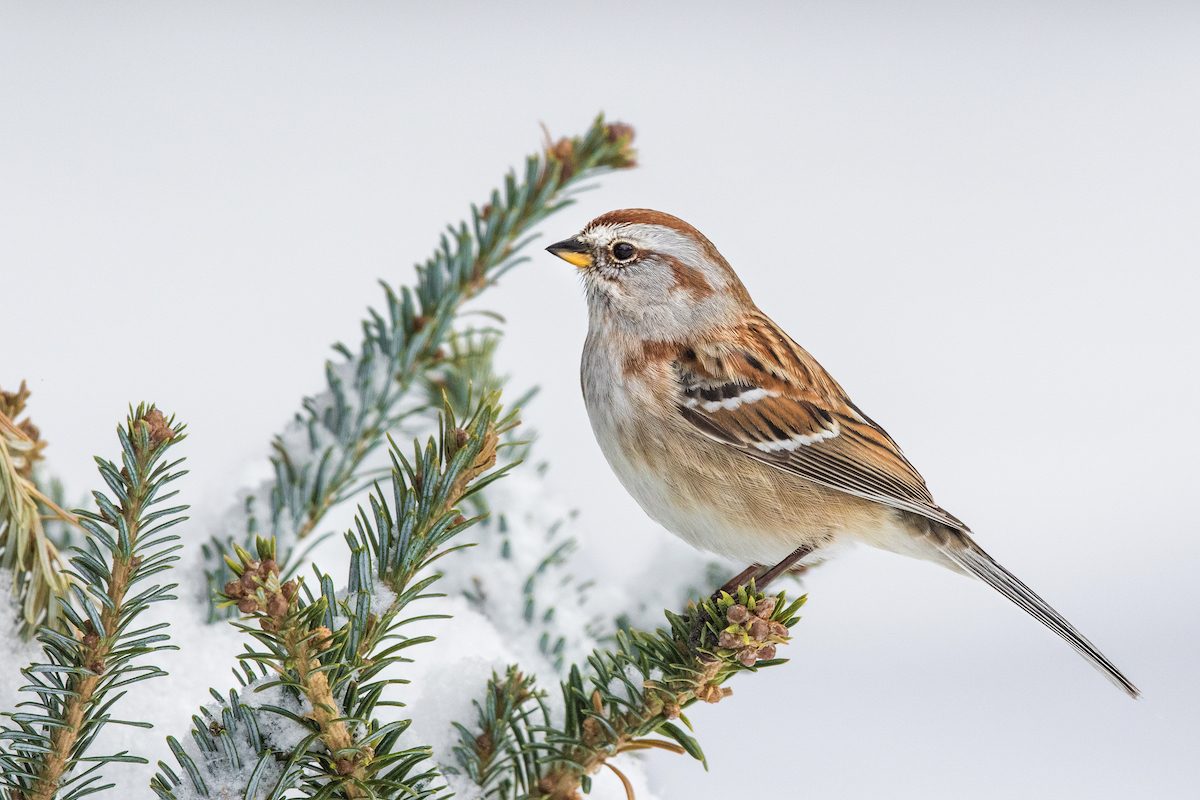Find out what an American tree sparrow looks like and sounds like. This small bird arrives in much of the lower 48 to spend the winter.

Identify and Attract an American Tree Sparrow

On This Page
American Tree Sparrow Identification

If you think you’ve seen a chipping sparrow in winter, you might want to take a second look. You may be seeing an American tree sparrow— a winter visitor throughout the central and northern U.S.
Identifying American tree sparrows can be tricky, because some sparrows tend to resemble each other. Looking for a reddish cap, white wing bars, or the presence of a line by the eye might not be enough to distinguish the bird from look-alikes.
“There are some people who will tell you all sparrows look alike, because they have streaking on their back, and wing bars, and they’re mainly brown and rusty,” says David Wiedenfeld, senior conservation scientist with the American Bird Conservancy. “[American tree sparrows] share a lot with a number of other sparrows. Not a lot of bright colors, not a lot of really distinctive marks.”
With that said, David mentions that a good way to tell these specific sparrows apart from similar species like chipping and field sparrows is to look at their breast. “The identifying thing on them is that their breast is pretty much solid-colored with one spot in the middle,” he says.
Learn how to identify white-throated sparrows.
Range and Habitat

Rarely a forest bird, American tree sparrows are most commonly found mostly open areas with a few trees, shrubs, or places to perch. “A lot of them winter in the Great Plains along streams and wherever there are woods and scrubby trees along creeks, and so forth,” David says.
As David points out, American tree sparrows’ migration patterns are unusual. While most birds head for warmer places when cold weather sets in, for these tough sparrows, the United States’ winter is their warmer climate. They spend breeding season in northern Canada only to fly south to much of the Midwestern and Northeastern United States.
Diet: What Do American Tree Sparrows Eat?

Because they tend to settle in suburban environments, American tree sparrows are a relatively common feeder bird. “They’re not uncommon in suburban landscapes where you have people with shrubs in their yards or along their fences, or maybe a creek runs through the neighborhood or something like that,” David says.
Their favorite feeder foods include nyjer (thistle), cracked corn, white proso millet and hulled sunflower seed. Unlike many sparrows, you can find this sparrow eating suet in addition to seed. “They can be pretty common in places where people see them, and if you have a feeder in your yard, they will come to that, as well,” David says.
Nesting Habits
Unless you live in the harsher portions of northern Canada, you won’t likely see an American tree sparrow during breeding season. Their nests are usually found on or near the ground. The female lays four to six eggs, and less than two weeks after hatching, the young birds leave the nest.
Discover more fascinating sparrow facts you should know.
American Tree Sparrow vs Chipping Sparrow

The time of year when you see the birds can be a clue to identifying them. As the seasons change, look for American tree sparrows to replace the chipping sparrows in your backyard.
Chipping sparrows live in the northern United States in summer, migrating to the southern states in fall. American tree sparrows spend summers in the Arctic, appearing south of Canada only from late fall to early spring. The tree sparrow is slightly larger, with more obvious white wing bars. The stripe behind its eye is reddish brown, not black or dark gray as on the chipping sparrow.
Pay attention to different bill colors, as well. They are bicolored black and yellow on tree sparrows, while chipping sparrows’ bills are black in summer and partly dull pink in winter.
American Tree Sparrow Song and Calls
Bird sounds courtesy of the Cornell Lab of Ornithology
Males sing a cheery-sounding cascade of falling notes, some sung individually, and some jumbled together. Calls are a high-pitched tseet or teedle-eet.
Next, learn how to attract dark-eyed juncos to your backyard.
About The Expert
As senior conservation scientist for American Bird Conservancy, David Wiedenfeld has worked on research pertaining to bird populations for decades. He served as Director of Research at the Sutton Avian Research Center, and he also served as Head of the Department of Vertebrate Ecology at the Charles Darwin Research Station in the Galapagos Islands. He holds a doctorate in biological science from Florida State University, and his favorite bird is the swallow-tailed kite.
Sources
- Cornell Lab of Ornithology, “American Tree Sparrow: Life History“
- Audubon Field Guide, “American Tree Sparrow“




















